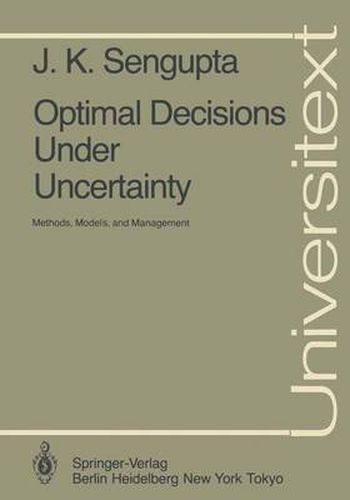Readings Newsletter
Become a Readings Member to make your shopping experience even easier.
Sign in or sign up for free!
You’re not far away from qualifying for FREE standard shipping within Australia
You’ve qualified for FREE standard shipping within Australia
The cart is loading…






This title is printed to order. This book may have been self-published. If so, we cannot guarantee the quality of the content. In the main most books will have gone through the editing process however some may not. We therefore suggest that you be aware of this before ordering this book. If in doubt check either the author or publisher’s details as we are unable to accept any returns unless they are faulty. Please contact us if you have any questions.
Understanding the stochastic enviornment is as much important to the manager as to the economist. From production and marketing to financial management, a manager has to assess various costs imposed by uncertainty. The economist analyzes the role of incomplete and too often imperfect information structures on the optimal decisions made by a firm. The need for understanding the role of uncertainty in quantitative decision models, both in economics and management science provide the basic motivation of this monograph. The stochastic environment is analyzed here in terms of the following specific models of optimization: linear and quadratic models, linear programming, control theory and dynamic programming. Uncertainty is introduced here through the para meters, the constraints, and the objective function and its impact evaluated. Specifically recent developments in applied research are emphasized, so that they can help the decision-maker arrive at a solution which has some desirable charac teristics like robustness, stability and cautiousness. Mathematical treatment is kept at a fairly elementary level and applied as pects are emphasized much more than theory. Moreover, an attempt is made to in corporate the economic theory of uncertainty into the stochastic theory of opera tions research. Methods of optimal decision rules illustrated he re are applicable in three broad areas: (a) applied economic models in resource allocation and economic planning, (b) operations research models involving portfolio analysis and stochastic linear programming and © systems science models in stochastic control and adaptive behavior.
$9.00 standard shipping within Australia
FREE standard shipping within Australia for orders over $100.00
Express & International shipping calculated at checkout
Stock availability can be subject to change without notice. We recommend calling the shop or contacting our online team to check availability of low stock items. Please see our Shopping Online page for more details.
This title is printed to order. This book may have been self-published. If so, we cannot guarantee the quality of the content. In the main most books will have gone through the editing process however some may not. We therefore suggest that you be aware of this before ordering this book. If in doubt check either the author or publisher’s details as we are unable to accept any returns unless they are faulty. Please contact us if you have any questions.
Understanding the stochastic enviornment is as much important to the manager as to the economist. From production and marketing to financial management, a manager has to assess various costs imposed by uncertainty. The economist analyzes the role of incomplete and too often imperfect information structures on the optimal decisions made by a firm. The need for understanding the role of uncertainty in quantitative decision models, both in economics and management science provide the basic motivation of this monograph. The stochastic environment is analyzed here in terms of the following specific models of optimization: linear and quadratic models, linear programming, control theory and dynamic programming. Uncertainty is introduced here through the para meters, the constraints, and the objective function and its impact evaluated. Specifically recent developments in applied research are emphasized, so that they can help the decision-maker arrive at a solution which has some desirable charac teristics like robustness, stability and cautiousness. Mathematical treatment is kept at a fairly elementary level and applied as pects are emphasized much more than theory. Moreover, an attempt is made to in corporate the economic theory of uncertainty into the stochastic theory of opera tions research. Methods of optimal decision rules illustrated he re are applicable in three broad areas: (a) applied economic models in resource allocation and economic planning, (b) operations research models involving portfolio analysis and stochastic linear programming and © systems science models in stochastic control and adaptive behavior.